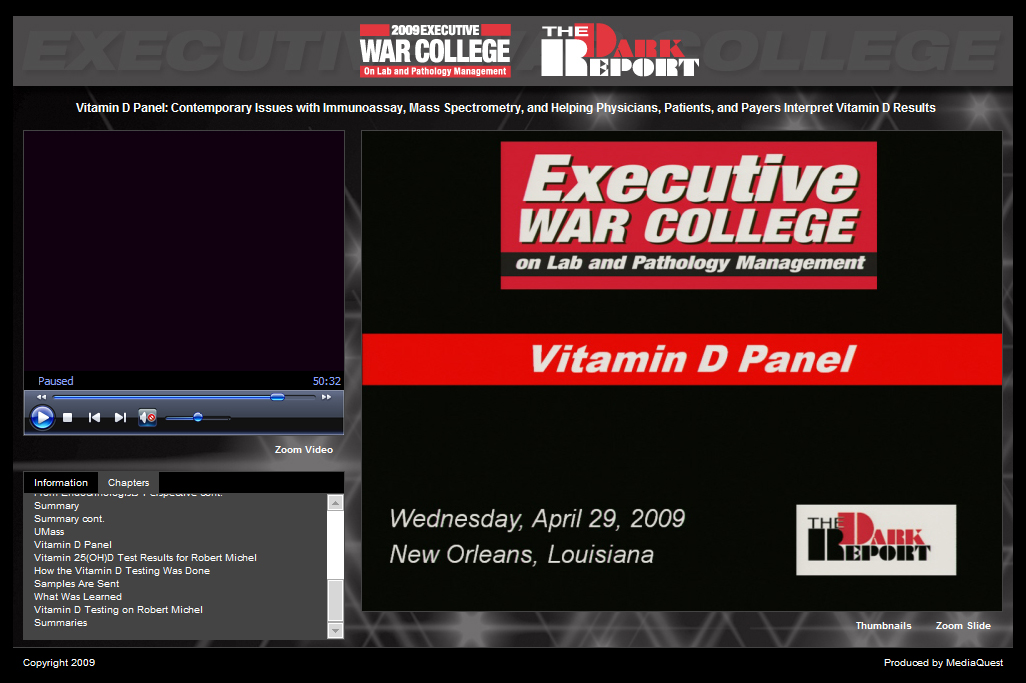FREE Video Training – VITAMIN D Expert Panel Discussion!
Different Methodologies Produce Different Numbers
Over the last 30 months, Vitamin D tests have become an extremely high volume assay at many laboratories. But in order to translate this new influx of Vitamin D test volume into increased revenues, laboratories must know the ins and out of the different methodologies used to administer the test. There is no better way to get up to speed than to hear exactly what you need to know directly from the mouth of those who know the topic best. And that is now possible by downloading the fascinating panel discussion that took place at the Dark Report’s Executive War College in New Orleans last April. If you were unable to make it to New Orleans, this webinar is a great opportunity to learn everything you need to know about Vitamin D testing including insights in regard to methodology, diagnostic capabilities, and effective ways to design reports and help physicians recognize the clinical significance of the results reported on their patients.
In TODAY’S HYPERACTIVE MARKET for Vitamin 25(OH) D testing, the typical clinical laboratory faces at least two challenges as it tries to offer best practices to its physicians and patients. The first challenge is adjusting to a new competitor for the immunoassay (IA) that has been used widely and has become familiar to most physicians over the last two decades. The new kid on the block is a Vitamin 25(OH) D home brew assay that uses tandemmass spectrometry. The problem is that results produced by these different methodologies often do not correlate. This has caused confusion among clinicians who have years of experience with the Vitamin 25(OH) D results produced by the immunoassay method but do not fully appreciate why the Vitamin D result produced by tandem mass spec can differ from the immunoassay.
* L.V. Rao, Ph.D., Director of Core Laboratories, UMass Memorial Medical Center;
* Andre Valcour, Ph.D., VP, Director of Laboratories, Laboratory Corporation of America;
* Russell Grant, Ph.D., Strategic Director, National Office of Quality & Science, Esoterix, Inc.;
* Bruce Hollis, Ph.D., MUSC;
The second problem is that despite the vast chasm separating the two methodologies, labs still report their results using similar reference ranges. This has led to confusion across the laboratory testing industry because so little effort has been made to educate lab professionals about the situation. Not surprisingly, this has led to a lot of confusion, particularly for those clinicians whose managed care contracts require the use of multiple labs. This confusion leads to fiscal inefficiency and a far lower standard of care for patients. In New England resolving these two issues in Vitamin 25(OH) D testing created significant clinical challenges for the laboratory at the University of Massachusetts Medical Center. Using the experiences in New England as a starting point, a panel of experts at the Executive War College on Laboratory and Pathology Management in New Orleans expounded on what labs can do to avoid the Vitamin D testing pitfalls many of their competitors are facing.
The Dark Report Publisher Robert Michel recently stepped to the plate to seek out what is really going on with Vitamin D testing. He reported the results are not good, especially in relation to a certain laboratory. Michel sent 24 aliquots, or identical samples, of his blood, all drawn the same day, to two different reference labs. The labs in turn sent the aliquots for 24 Vitamin D blood tests over a three week period. In a perfect world, 24 blood samples, drawn from the same person at the same time would all test the same. However, the results varied from 36 ng/ml to 66 ng/ml! Not only do we not live in a perfect world, but in regard to Vitamin D testing we do not live in a world that is even acceptably flawed. This certain laboratories results: 36, 42, 51, 54, 55, and 66. The Mayo Clinic, which uses the same technique as this lab uses, did better, 48, 48, 51, and 61. The good news was the immunoassay methods used by LabCorp, Clinical Pathology Labs, and ARUP clustered around 44 ng/ml and all 11 samples were within 4 points of 44 ng/ml, with the highest 48 and the lowest 39.6.
In short, if you use a lab other then LabCorp, Clinical Pathology Labs, and ARUP you might want to consider dividing the results by 1.3 while hoping they continue to work at improving their process. Mayo is better at it, but Dr. Singh must be getting tired of all those Vitamin D tests because they are hard to do on mass spec. If your lab sends out to LabCorp, ARUP, or Clinical Pathology Labs, you are in good hands. If you use ZRT, you should know that it is a mass spec technique; it has to be mass spec to be done on a blood spot. ZRT is also harmonized to the gold standard. Or rather, ZRT is corrected to the gold standard. By gold standard I mean the method that the scientific studies use when they study cancer, heart disease, autoimmune disease, etc. When you see an article that says a new study showed higher Vitamin D levels are associated with longer life, etc., that study almost always used DiaSorin RIA, the gold standard, or DiaSorin Liaison, which gives almost identical results to the DiaSorin RIA.
Call the Dark Daily office at 512-264-7103





